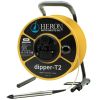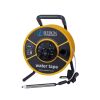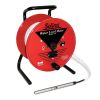Heron dipper-Tough Water Level Meters
Features
- Fully pressure/depth rated 5/8" probe
- Hydrocarbon-resistant, Kynar jacketed steel core tape
- Includes padded carry case with tape guide and hanger
- Free ground shipping
- Expedited repair and warranty service
- Lifetime technical support
- More
Overview
The Heron dipper-Tough Water Level Meter is a rugged, top-quality instrument used for measuring static and falling head levels in waste disposal and remediation sites and other harsh environments. The drawDown feature on the dipper-Tough makes this unit ideal to use during pump and treat testing when contaminates are found in the groundwater. The hydrocarbon-resistant Kynar jacketed, high tensile steel core tape is embedded directly into the probe body, allowing for a longer life of the tape and probe.
Benefits
- Electronic Module (IP65): Mode selectable for static and drawDown levels, removable for easy cleaning and servicing
- Probe (IP68): Fully pressure/depth rated 5/8”
- Steel Tape: High tensile steel, jacketed with Kynar, high break strength, stretch resistant and lifelong legibility – markings in engineering scale (1/100’) or metric (mm)
- Padded Carry Case: Protects the precision water level meter from the elements
- Tape Guide and Hanger: Supports the meter at the well head and protects the tape from sharp edges on the well casing
- Vinyl Holding Grip: Molded to the frame, ergonomic easy grip
- Winding Handle: Custom-made for easy rewinding with gloved hands
- Premium Stainless Steel Kynar Coated Tape
- 5/8” (15.9mm) Water Level Probe (IP68) w/ holder
- Electronic Panel with audio and visual signals (Fully Encapsulated to IP65)
- Sensitivity dial
- Vinyl, ergonomic holding grip
- 9V Battery
- Backpack Carrying Case w/ adjustable straps, laptop & notepad pouches
In The News
From Hurricanes to Florida’s Red Tides: Monitoring the Southwest Gulf Coast
Nearly every year, southwest Florida is blighted by harmful Karenia brevis blooms–known colloquially as Florida red tides. These harmful algal blooms (HABs) form over the West Florida shelf and are pushed shorewards by winds and currents. Once in touching distance of the coast, they often intensify, fed by land-based runoff, anthropogenic nutrients, and decomposing marine life killed by toxins produced by these red tides. Red tides have become more severe and persistent over the past 20 years, causing major environmental and economic damage.
Read MoreWave-Powered Buoy Deployed in Puget Sound
While the development of solar-powered monitoring systems has improved access to real-time environmental data, solar power is still limited by low light conditions, such as poor weather, nighttime, or high-latitude environments. To supplement these incumbent power solutions at sea, Ocean Motion Technologies has developed a small-scale ocean wave energy system that can be directly integrated with existing data buoy platforms. Not only does wave energy supplement solar power during periods when the buoys are limited by light availability, but it also allows data buoys to perform beyond their current power capacities.
Read MoreLong-Term Monitoring in the Chautauqua Lake Watershed
With a widely developed shoreline, Chautauqua Lake experiences influxes of non-point source pollution that have historically impacted the health of the lake. The Chautauqua Lake Association (CLA) has been monitoring the lake for over two decades, reporting on changes that have occurred over the years. A pair of local lake advocates, Jane and Doug Conroe, have lived on the lake for over 40 years and have played an important role in establishing monitoring programs and facilitating consistent data collection throughout the watershed. Doug has been involved with the Chautauqua Lake Association (CLA) since the pair moved to the area in 1980, and is currently serving as the Executive Director.
Read More






















